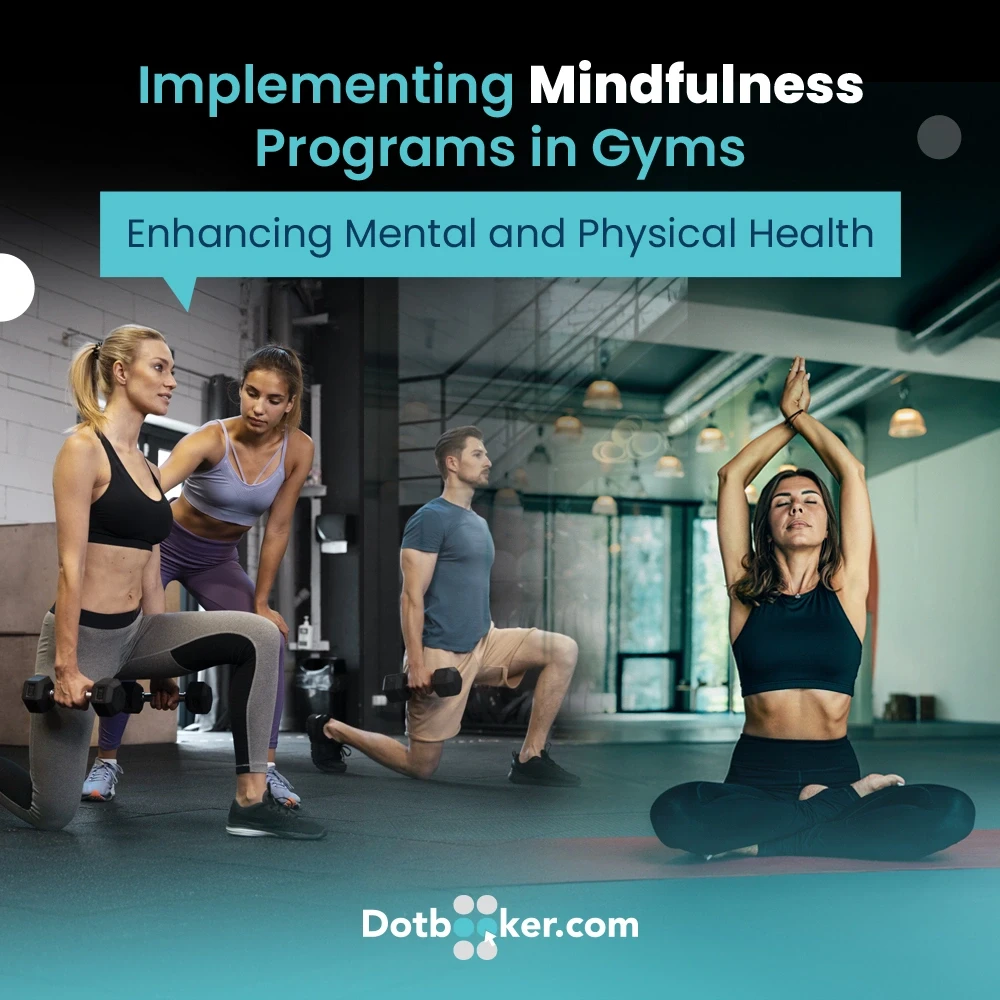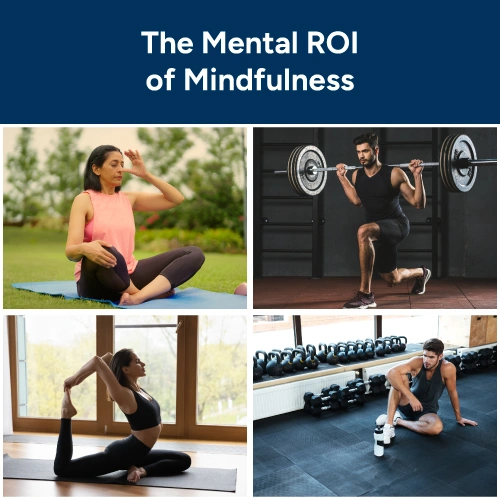
- By Dotbooker
- May 12, 2025
- 592
Implementing Mindfulness Programs in Gyms: Enhancing Mental and Physical Health
There was a time when gym success was measured in kilos lifted, miles run, or calories burned. But today? It's just as much about emotional resilience, mental clarity, and staying grounded.
Because let’s face it—mental wellness in fitness isn’t a luxury anymore. It’s survival.
We live in a world that constantly pushes us to “go hard or go home.” But what if we chose a third path? One where sweat and stillness coexist, where lifting weights is followed by letting go. That’s exactly where mindfulness programs in gyms are making their mark—shifting fitness culture from purely performance-driven to profoundly person-driven.
Sweat Alone Isn’t Healing Anymore
Every gym promises results—toned muscles, shredded cores, lean physiques. But increasingly, members are walking in carrying invisible weight: workplace pressure, screen fatigue, burnout, anxiety. A few reps won’t fix that.
This is where traditional fitness hits a wall.
Physical and mental health are no longer two parallel lanes—they’re intertwined. Members are not just chasing six-packs. They’re seeking peace, clarity, and an emotional reset. And if a gym doesn’t provide that? They’ll find one that does.
Cue the rise of holistic gym approaches—fitness models that combine movement with mindfulness, effort with ease.

What Exactly Is Mindfulness in a Gym Setting?
Let’s clarify something right away: mindfulness in gyms doesn’t mean swapping your deadlifts for deep breaths or turning every treadmill session into a silent retreat. It’s not about softening the workout—it’s about sharpening the awareness.

Mindfulness in a fitness setting is the conscious practice of staying present and fully engaged with your movement, your breath, and your environment. It transforms autopilot reps into intentional movements and mindless cardio into moments of connection with your body.
Here's how this integration is showing up in modern gym businesses:
- Guided breathwork before intense cardio: Not just a warm-up, but a way to steady the nervous system, improve oxygen flow, and mentally prepare for high-impact movement. It calms performance anxiety, reduces early fatigue, and helps members start strong.
- Stretching sessions with mindfulness cues: Trainers guide members to “notice how your hamstrings feel today” or “breathe into areas of tension.” It’s subtle—but powerful. Members learn to listen to their bodies rather than pushing through discomfort unthinkingly.
- Meditation rooms or ‘cooldown corners’: These tranquil zones are now designed with dim lights, nature-inspired sounds, and floor cushions to help members unwind post-workout. Some gyms use scent diffusers and mood lighting to enhance the sensory experience.
- Mindful strength training: Instead of rushing through a set, members are encouraged to focus on form, tempo, and muscle engagement. Cues like “Feel your feet grounded” or “Exhale as you push” anchor the mind to the body, enhancing both results and satisfaction.
- Pre-recorded sound baths and visualizations: Available via gym apps or smart kiosks, these are often used during rest days or post-workout to aid recovery. Visualization exercises, especially in sports-focused gyms, help members mentally rehearse lifts or routines with clarity.
- Mindfulness check-ins before and after workouts: Some boutique gyms even use quick mood trackers or digital journals to encourage members to log how they feel, not just how they performed.
When these practices are structured and integrated—not just added for show—they become part of mindfulness programs in gyms that evolve into genuine value offerings. These aren’t just “nice-to-haves.” They’re measurable, repeatable, and trackable experiences that help clients achieve better balance, on and off the mat.
Why It Works: The Mental ROI of Mindfulness
Mindfulness might feel soft, but its impact is anything but.
In the same way progressive overload builds muscle, consistent mindfulness builds mental resilience. It’s a tool rooted in neuroscience, performance psychology, and behavioral science, and delivers results inside and outside the gym.

Let’s break down what the research (and lived experience) tells us:
- Lowers cortisol: Chronic stress increases cortisol, affecting fat storage, sleep, recovery, and even immune health. Mindfulness lowers cortisol levels, allowing the body to recover faster and function better.
- Enhances focus and decision-making: Mindful Members tend to train with better form, make fewer errors, and are more responsive to coaching. Their workouts are not just intense—they’re intentional.
- Boosts serotonin and dopamine, the "feel-good" chemicals that promote happiness and motivation. By encouraging mindful movement, gyms help members leave in a better headspace than when they arrived, boosting retention and loyalty.
- Reduces burnout and overtraining: High-achieving members are prone to pushing past their limits. Mindfulness gives them tools to notice fatigue, honor rest, and avoid injury or mental exhaustion.
This is why we’re seeing the rise of stress reduction workouts—sessions that incorporate effort and ease. Imagine ending a powerful HIIT circuit with a five-minute guided body scan. Heart rate comes down. Breath steadies. Members walk out feeling complete, not crushed.
And that’s what gets them to come back.
Because let’s face it—no one brags about a workout that left them feeling broken. But one that made them feel strong, clear, and centered? That becomes a ritual.

Gyms of the Future: The Mind-Body Transformation
The gym of the past was transactional: enter, lift, leave.
The gym of the future is transformational.
Modern gyms do more than just train muscles—they also train nervous systems, emotional intelligence, and self-awareness. It’s a whole-body upgrade, and the most successful fitness centers are adapting fast to holistic gym approaches.
Let’s explore how this shift is playing out:
- Membership packages now include wellness credits: These can be used for mindfulness classes, coaching check-ins, or recovery sessions. This adds perceived value while promoting balance in training schedules.
- Trainers are evolving into wellness mentors: Certifications in breathwork, emotional wellness, or somatic coaching are becoming part of the job description. They’re not just spotting your squat but helping you reset your stress response.
- App integrations go beyond reps and sets: Members can access gratitude journaling prompts, short meditation audios, or breathing timers between workouts, transforming idle time into recovery time.
- Fitness tracking is going beyond performance: Wearables and smart apps are now monitoring sleep quality, mood trends, HRV (heart rate variability), and even emotional states. These KPIs tell a richer story of overall health.
- Community-led wellness: Mindfulness circles, journaling workshops, or post-class tea sessions give members a sense of connection, especially in urban environments where people often feel isolated.
The emotional payoff? Members feel seen, safe, and supported—not just in losing weight or building strength but also in navigating life’s chaos more calmly.
This kind of transformation builds long-term loyalty, advocacy, and referrals.

Building Mindfulness Into Your Gym’s DNA
It’s easy to think of mindfulness as the garnish on the fitness plate—a bonus class here, a guided meditation there. But when mindfulness is treated as a core ingredient, the whole flavor of your gym experience changes.
When integrated into your gym’s culture, communication, and curriculum, mindfulness becomes a silent differentiator—one that your members feel the moment they walk through your doors.
Here’s how gyms can bake mindfulness into their DNA:
- Mindful Onboarding: Go beyond physical goals. Include questions like:
- “Do you currently practice meditation or breathwork?”
- “What helps you reset mentally after a stressful day?”
These answers help trainers personalize not just workouts, but whole-person wellness plans.
- Mindfulness Calendar: Create a monthly schedule with rotating weekly themes:
- Week 1: Intentional Movement
- Week 2: Gratitude in Strength
- Week 3: Present-Moment Cardio
- Week 4: Recovery Through Stillness
Display it digitally or on community boards to spark curiosity and inspire attendance.
- Fusion Classes: Introduce hybrid formats like:
- “Burn & Breathe” – a fusion of high-intensity training followed by grounding breathwork.
- “Sweat & Stillness” – 30 minutes of circuit training, 15 minutes of meditation.
- “Core & Calm” – ab-focused workouts followed by guided body scans.
These classes break the traditional rhythm in the best way.
- Mindful Aesthetics: Dedicate a zone (or even a corner) to mindful recovery. Use:
- Dimmed or color-shifting lighting.
- Natural elements like plants, bamboo walls, or water sounds
- Aromatherapy diffusers with lavender or sandalwood
This tells members: “We care about how you feel, not just how you look.”
- Tech and Wellness Partnerships: Collaborate with:
- Meditation or journaling apps
- Wearables that track HRV and sleep
- Local wellness coaches for pop-up events
This adds instant value without overloading internal staff.
- Mini Mindful Moments: Introduce quick routines that are easy to adopt, such as:
- 3-minute morning intention circles before group classe
- 5-minute post-spin stretch & reflect segments
- Journaling prompts printed near water fountains
Tiny practices—repeated consistently—can create massive emotional stickiness.
You're not just adding variety by weaving mindfulness into the fabric of your gym’s identity. You’re building a brand that feels different, driving member loyalty in 2025 and beyond.
Mindfulness Isn’t Just a Trend—It’s a Competitive Edge
Let’s be honest: every gym has equipment and can offer group classes. But not every gym understands that wellness is more than muscle—it’s mental clarity, emotional resilience, and the ability to slow down without guilt.
This is the edge mindfulness gives.
Gyms that offer mindfulness programs do more than compete—they connect. They build relationships with members that go deeper than goals on a whiteboard. These are the gyms people don’t just attend—they belong to.
Think about it:
- A gym that knows how you slept last night.
- A gym that celebrates your first meditation milestone.
- A gym that checks in when you’ve missed a week, not with pressure, but with presence.
That’s not a fitness facility. That’s a wellness partner.
And that’s how the community grows, how word-of-mouth spreads. How businesses thrive.

Your Gym’s Next Move? Make Space for the Mind
Fitness used to be all about the external—bigger lifts, faster times, leaner bodies. But today’s members crave internal growth, too. They want to be strong, yes, but also centered, energized but not anxious, and fit but not fried.
Integrating mindfulness programs in gyms doesn’t mean slowing down your brand. It means elevating it.
By giving your members tools to navigate life, not just reps, you become part of their lifestyle, not just their routine.
And this is exactly where Dotbooker steps in.
Dotbooker is more than a booking system—it’s a platform designed for modern fitness and wellness businesses. Whether you’re scheduling a breathwork workshop, setting up hybrid HIIT-mindfulness classes, or offering digital check-ins for journaling and reflection, Dotbooker helps you:
- Automate class bookings and instructor management
- Offer flexible membership plans that include mindfulness access.
- Integrate personalized services with minimal operational hassle.
- Monitor engagement across both physical and mental health offerings
With Dotbooker, you don’t just manage members—you mindfully serve them.
Reimagining Fitness: One Breath at a Time
In this fast-paced world, the real flex is knowing when to pause.
It’s time your gym changed not just bodies but lives.
Bring mindfulness programs in gyms from the sidelines to center stage. Your members are ready for it, and the industry is shifting toward it. With Dotbooker, you're already equipped to lead that change.
Ready to rewire your gym culture from the ground up?
Let Dotbooker help you blend muscle with mindfulness—and build a space where both can thrive.
Popular Blogs

- Oct 20, 2022
- 4341

- Sep 08, 2024
- 3544

- Nov 11, 2022
- 3035

- Sep 16, 2024
- 2491
Transform your business now!

Get an expert consultation for your business's streamlined operations.